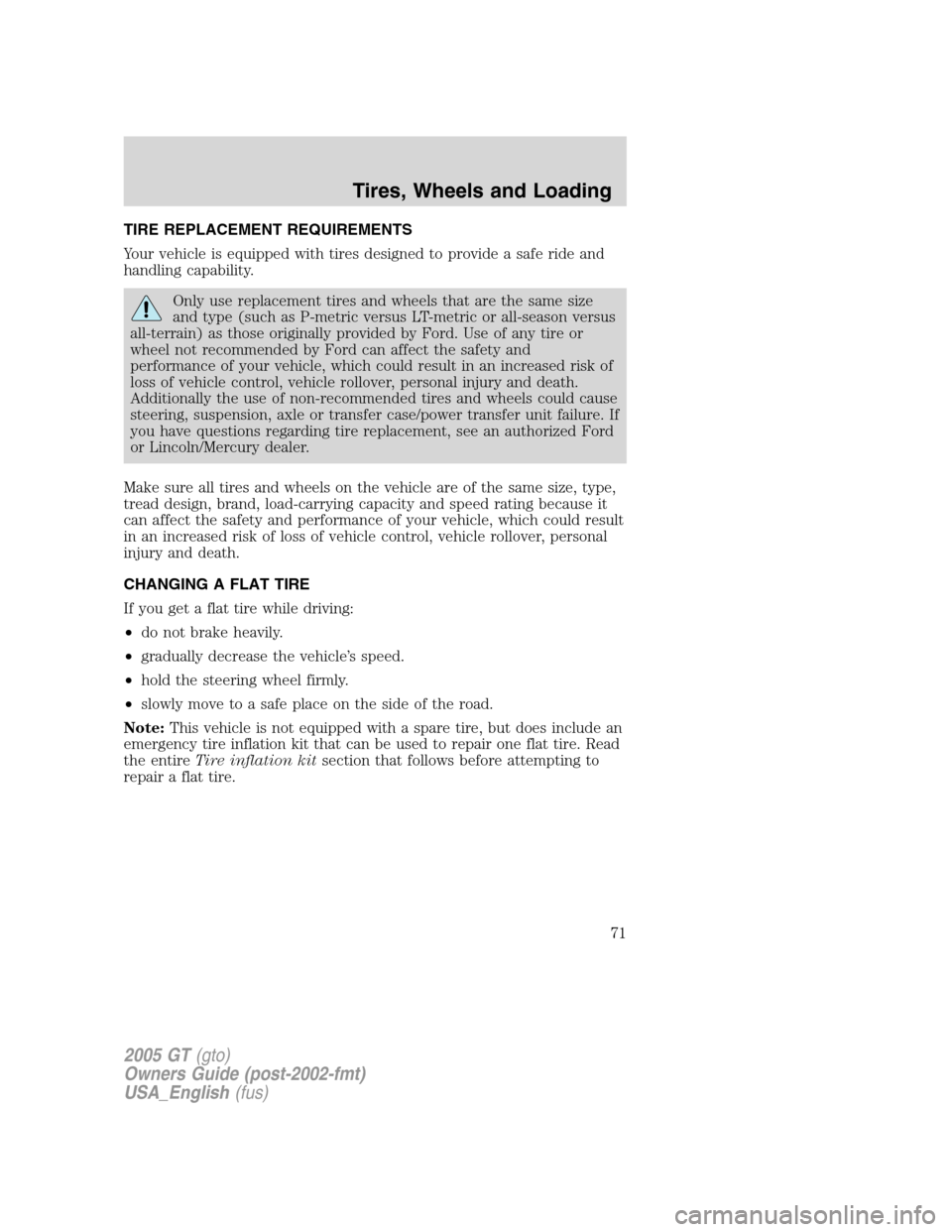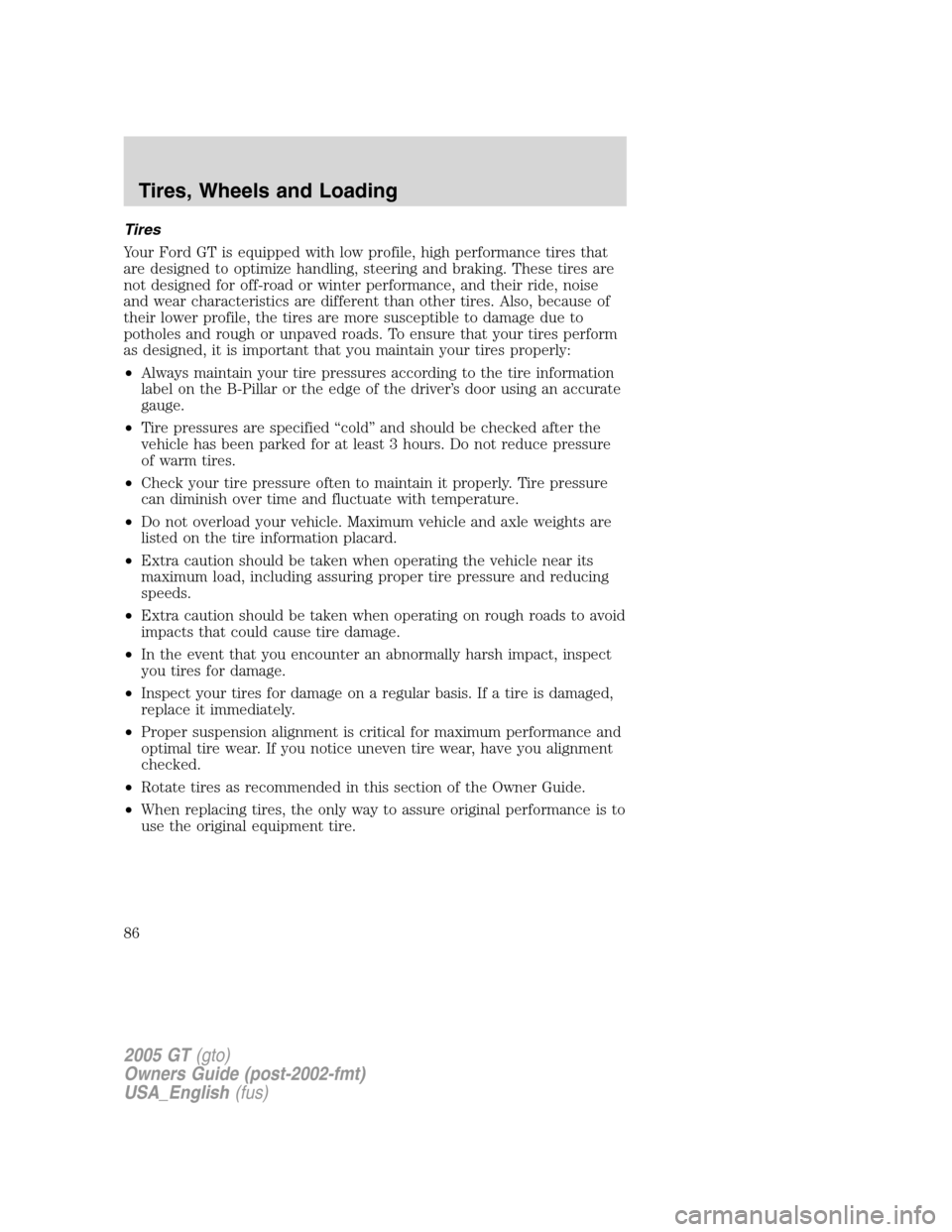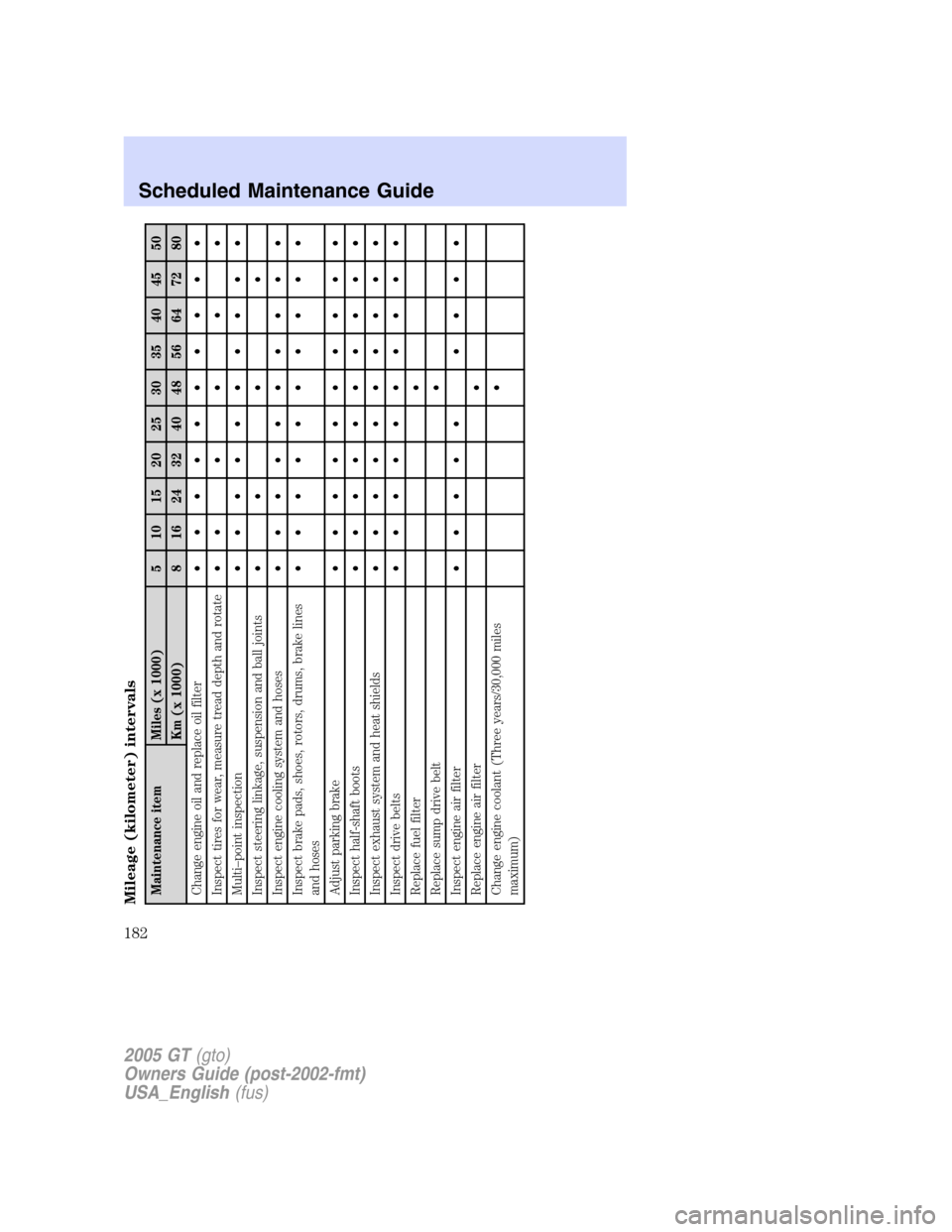2005 FORD GT suspension
[x] Cancel search: suspensionPage 71 of 200

TIRE REPLACEMENT REQUIREMENTS
Your vehicle is equipped with tires designed to provide a safe ride and
handling capability.
Only use replacement tires and wheels that are the same size
and type (such as P-metric versus LT-metric or all-season versus
all-terrain) as those originally provided by Ford. Use of any tire or
wheel not recommended by Ford can affect the safety and
performance of your vehicle, which could result in an increased risk of
loss of vehicle control, vehicle rollover, personal injury and death.
Additionally the use of non-recommended tires and wheels could cause
steering, suspension, axle or transfer case/power transfer unit failure. If
you have questions regarding tire replacement, see an authorized Ford
or Lincoln/Mercury dealer.
Make sure all tires and wheels on the vehicle are of the same size, type,
tread design, brand, load-carrying capacity and speed rating because it
can affect the safety and performance of your vehicle, which could result
in an increased risk of loss of vehicle control, vehicle rollover, personal
injury and death.
CHANGING A FLAT TIRE
If you get a flat tire while driving:
• do not brake heavily.
• gradually decrease the vehicle ’s speed.
• hold the steering wheel firmly.
• slowly move to a safe place on the side of the road.
Note: This vehicle is not equipped with a spare tire, but does include an
emergency tire inflation kit that can be used to repair one flat tire. Read
the entire Tire inflation kit section that follows before attempting to
repair a flat tire.
2005 GT(gto)
Owners Guide (post-2002-fmt)
USA_English (fus)
Tires, Wheels and Loading
71
Page 86 of 200

Tires
Your Ford GT is equipped with low profile, high performance tires that
are designed to optimize handling, steering and braking. These tires are
not designed for off-road or winter performance, and their ride, noise
and wear characteristics are different than other tires. Also, because of
their lower profile, the tires are more susceptible to damage due to
potholes and rough or unpaved roads. To ensure that your tires perform
as designed, it is important that you maintain your tires properly:
•Always maintain your tire pressures according to the tire information
label on the B-Pillar or the edge of the driver ’s door using an accurate
gauge.
• Tire pressures are specified “cold ”and should be checked after the
vehicle has been parked for at least 3 hours. Do not reduce pressure
of warm tires.
• Check your tire pressure often to maintain it properly. Tire pressure
can diminish over time and fluctuate with temperature.
• Do not overload your vehicle. Maximum vehicle and axle weights are
listed on the tire information placard.
• Extra caution should be taken when operating the vehicle near its
maximum load, including assuring proper tire pressure and reducing
speeds.
• Extra caution should be taken when operating on rough roads to avoid
impacts that could cause tire damage.
• In the event that you encounter an abnormally harsh impact, inspect
you tires for damage.
• Inspect your tires for damage on a regular basis. If a tire is damaged,
replace it immediately.
• Proper suspension alignment is critical for maximum performance and
optimal tire wear. If you notice uneven tire wear, have you alignment
checked.
• Rotate tires as recommended in this section of the Owner Guide.
• When replacing tires, the only way to assure original performance is to
use the original equipment tire.
2005 GT(gto)
Owners Guide (post-2002-fmt)
USA_English (fus)
Tires, Wheels and Loading
86
Page 88 of 200

Wheel misalignment in the front or the rear can cause uneven and rapid
treadwear of your tires and should be corrected by a qualified technician
at a Ford or Lincoln/Mercury dealer. Front wheel drive (FWD) vehicles
and those with an independent rear suspension (if equipped) may
require alignment of all four wheels.
The tires should also be balanced periodically. An unbalanced tire and
wheel assembly may result in irregular tire wear.
Tire rotation
Because your vehicle is equipped with unique larger tires on the rear
wheels, you can only rotate tires side to side. You must not rotate tire in
a crisscross pattern or front to rear. If you notice that the tires wear
unevenly, have them checked.
Rotating your tires at the recommended interval (as indicated in the
Scheduled Maintenancechapter) will help your tires wear more evenly,
providing better tire performance and longer tire life. Unless otherwise
specified, rotate the tires approximately every 5,000 miles (8,000 km).
• Tire rotation
Sometimes irregular tire wear can be corrected by rotating the tires.
Note: If your tires show uneven wear ask a qualified technician at a
Ford or Lincoln/Mercury dealership to check for and correct any wheel
misalignment, tire imbalance or mechanical problem involved before tire
rotation.
Note: After having your tires rotated, inflation pressure must be checked
and adjusted to the vehicle requirements.
2005 GT(gto)
Owners Guide (post-2002-fmt)
USA_English (fus)
Tires, Wheels and Loading
88
Page 101 of 200

STEERING
To prevent damage to the power steering system:
•Never hold the steering wheel at its furthest turning points (until it
stops) for more than a few seconds when the engine is running.
• Do not operate the vehicle with a low power steering pump fluid level
(below the MIN mark on the reservoir). Refer to Checking and
adding power steering power fluid in theMaintenance and
Specifications chapter for information on checking and filling the
power steering fluid reservoir.
If the power steering system breaks down (or if the engine is turned
off), you can steer the vehicle manually, but it takes more effort.
If the steering wanders or pulls, check for:
• an improperly inflated tire
• uneven tire wear
• loose or worn suspension components
• loose or worn steering components
• improper steering alignment
A high crown in the road or high crosswinds may also make the steering
seem to wander/pull.
LIMITED-SLIP AXLE
This axle provides added traction on slippery surfaces, particularly when
one wheel is on a poor traction surface. Under normal conditions, the
limited slip axle functions like a standard rear axle.
Extended use of other than the manufacturer ’s specified size tires on a
limited slip rear axle could result in a permanent reduction in
effectiveness. This loss of effectiveness does not affect normal driving
and should not be noticeable to the driver.
PREPARING TO DRIVE YOUR VEHICLE
Your vehicle has special design features, such as a decreased ground
clearance; care should be taken when driving your vehicle near curbs,
speed bumps and parking lot bump-stops.
Use extra caution while becoming familiar with your vehicle. Know the
capabilities and limitations of both you as a driver and your vehicle.
2005 GT(gto)
Owners Guide (post-2002-fmt)
USA_English (fus)
Driving
101
Page 122 of 200

5. Transport the vehicle with the parking brake OFF and the
transmission in NEUTRAL.
6. Secure the vehicle with wheel basket tie-downs to the flatbed deck.
Note:Inspect tie-downs periodically for tightness. Never fasten J-hooks
to any suspension wheel or driveline component because J-hooks will
damage these components.
Note: If you have this vehicle transported by either air, water, or rail,
follow the wheel tie-down procedure starting with Step 5.
TOW HOOK
Your vehicle is equipped with a tow
hook located in the tire inflation kit
in the luggage compartment.
The tow hook should be threaded
into the hole provided in the front
grill area as shown. Note: This is a
left-handed thread.
2005 GT(gto)
Owners Guide (post-2002-fmt)
USA_English (fus)
Roadside Emergencies
122
Page 180 of 200

Multi-point Inspection
In order to keep your vehicle running right, it is important that you have
the systems on your vehicle checked regularly. This can help identify any
potential issue before there are any problems. Ford Motor Company
suggests the following multi-point inspection to be performed at every
scheduled maintenance as the way to ensure your vehicle keeps running
right.
Multi-point inspection - Recommended at every visit
•Check and top up fluid levels: brake, engine coolant recovery
reservoir, intercooler coolant, power steering and window washer.
• Inspect tires for wear and correct air pressure.
• Check exhaust system for leaks, damage, loose parts and foreign
materials.
• Check battery performance.
• Check operation of horn, exterior lamps, turn signals and hazard
warning lights.
• Check radiator, coolers and heater and air conditioning hoses.
• Inspect windshield washer spray and wiper operation.
• Check windshield for cracks, chips and pitting.
• Inspect for oil and fluid leaks.
• Inspect engine air cleaner filter and elements.
• Inspect half-shaft dust boots.
• Check shocks, struts and other suspension components for leaks and
damage.
NORMAL SCHEDULED MAINTENANCE AND LOG
The following maintenance schedule applies only if the vehicle is
operated in a typical manner. If the vehicle is operated in a non-typical
manner, maintenance frequency will be increased. The following
maintenance schedules are listed in both time intervals and mileage
(kilometer) intervals.
2005 GT(gto)
Owners Guide (post-2002-fmt)
USA_English (fus)
Scheduled Maintenance Guide
180
Page 181 of 200

ADDITIONAL INFORMATION AVAILABLE ON THE WEB
To learn more about the importance of routine and dealer-performed
maintenance on your vehicle, please visit the Ford Customer Service
website. You’ll also find important warranty information, customer
assistance, technical expertise, frequently asked questions and much
more. The website location is: www.ford.com.
Then go to the vehicles and service pick at the web site.
SCHEDULED MAINTENANCE TIME INTERVAL
Note: Repeat maintenance at scheduled intervals for the life of the
vehicle.
1 Year:
• Change engine oil
• Inspect engine and intercooler cooling systems
• Inspect engine air filter elements, replace if required
• Perform six month checks as outlined earlier in this section
• Inspect brake pads, shoes, rotors, drums, brake lines and hoses and
parking brake system.
• Inspect steering linkage, suspension, and ball joints
3 Years:
• Change engine oil
• Inspect engine and intercooler cooling systems
• Change manual transaxle fluid
• Perform six month checks as outlined earlier in this section
• Replace engine air filter elements
• Replace fuel filter
• Inspect brake pads, shoes, rotors, drums, brake lines and hoses and
parking brake system.
• Inspect steering linkage, suspension, and ball joints
2005 GT(gto)
Owners Guide (post-2002-fmt)
USA_English (fus)
Scheduled Maintenance Guide
181
Page 182 of 200

Mileage (kilometer) intervalsMaintenance item Miles (x 1000) 5 10 15 20 25 30 35 40 45 50Km (x 1000) 8 16 24 32 40 48 56 64 72 80
Change engine oil and replace oil filter ••••••••••
Inspect tires for wear, measure tread depth and rotate ••••••
Multi –point inspection ••••••••••
Inspect steering linkage, suspension and ball joints ••••
Inspect engine cooling system and hoses ••••••••••
Inspect brake pads, shoes, rotors, drums, brake lines
and hoses ••••••••••
Adjust parking brake ••••••••••
Inspect half-shaft boots ••••••••••
Inspect exhaust system and heat shields ••••••••••
Inspect drive belts ••••••••••
Replace fuel filter •
Replace sump drive belt •
Inspect engine air filter ••••• ••••
Replace engine air filter •
Change engine coolant (Three years/30,000 miles
maximum) •
2005 GT(gto)
Owners Guide (post-2002-fmt)
USA_English
(fus)
Scheduled Maintenance Guide
182